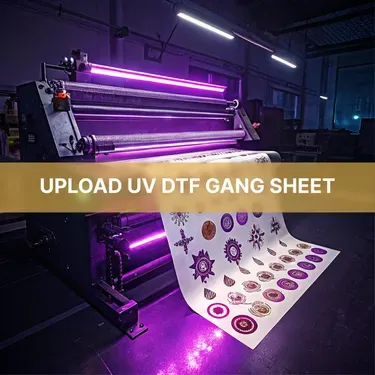In the realm of modern printing technologies, **UV DTF Gangheet** is rapidly establishing itself as a game-changer. This innovative approach merges the advantages of UV printing with the flexibility of Direct to Film (DTF) methods, empowering users to produce high-quality graphics on an extensive range of substrates. As industries evolve in their quest for vibrant and durable prints, UV DTF Gangheet stands out, simplifying the process and reducing the need for elaborate surface pre-treatments. In this guide, we will explore essential printing tips, techniques, and tricks to help both seasoned professionals and newcomers navigate the exciting world of UV DTF. Get ready to elevate your printing game and discover the potential of this versatile print technique.
UV DTF Gangheet, often referred to as ultraviolet direct-to-film printing, offers a revolutionary solution for producing stunning designs on various surfaces. This process combines UV technology with film-based printing, allowing for exceptional color vibrancy and detail without lengthy surface preparations. Known for its adaptability, ultraviolet direct-to-film printing can cater to diverse materials ranging from textiles to plastics and metals. Whether you are focusing on creating promotional items, custom apparel, or intricate artwork, this technique provides an efficient and high-quality alternative to traditional print methods. As we delve deeper into the fundamentals of this cutting-edge printing strategy, prepare to uncover invaluable insights and enhance your production capabilities.
Understanding the Basics of UV DTF Printing
UV DTF printing, or UV Direct to Film printing, is an innovative technique that seamlessly integrates UV printing technology with Direct to Film methodologies. In this process, UV inks are printed onto a special film, which is then transferred onto a wide range of substrates. This hybrid approach not only facilitates vibrant color production but also enhances durability, setting it apart from traditional printing methods. The ability to print on diverse materials such as textiles, plastics, and wood makes UV DTF an incredibly versatile option for modern printing businesses.
In addition to its impressive versatility, UV DTF printing stands out due to its minimal need for surface preparation. Traditional methods often require extensive pre-treatment of surfaces to ensure proper ink adhesion. Still, UV DTF allows for efficient workflows without sacrificing quality. This means that whether you are working on apparel, promotional items, or even industrial applications, you can achieve stunning results with less hassle and faster turnaround times.
The Unique Benefits of UV DTF Gangheet
UV DTF Gangheet offers numerous advantages that appeal to businesses looking for cutting-edge printing solutions. One of the foremost benefits is its ability to produce high-quality graphics that maintain their vibrancy over time. The UV inks used in this printing technique dry instantly, ensuring that the prints are both sharp and detailed. Coupled with this is the excellent resistance to fading and wear, making it an ideal choice for products that will be used outdoors or in high-stress environments.
Furthermore, the efficiency of UV DTF printing can lead to significant time and cost savings. With less requirement for extensive setup and preparation, businesses can increase their production outputs without compromising on the quality of the final product. This streamlined approach allows for more flexibility in fulfilling orders, catering to smaller runs or custom projects that demand quick turnaround, thereby enhancing customer satisfaction.
Exploring Substrate Compatibility in UV DTF
A critical aspect of achieving optimal results in UV DTF Gangheet is understanding substrate compatibility. Each material presents its own challenges and benefits, and knowing how to handle them can significantly impact print quality. For instance, textiles such as cotton and polyester may require specific pre-treatment processes to ensure the print adheres correctly. Utilizing the right techniques can help prevent issues like cracking or peeling, allowing the printed graphics to stretch and move with the fabric.
On the other hand, when printing on plastics, selecting an appropriate film is vital. The film’s adhesive properties need to match the specific type of plastic being used to avoid peeling or bubbling. Similarly, printing on harder surfaces like metals requires a clean and smooth substrate to achieve optimal ink adhesion. Tailoring your approach to each substrate type ensures the longevity and quality of your prints, making substrate compatibility a pivotal factor in the UV DTF printing process.
Choosing the Right Film for Your Prints
Film selection is another crucial element in the UV DTF Gangheet process. The choice between thicker or thinner films can greatly influence the print’s final appearance and durability. Thicker films tend to offer greater rigidity and can withstand more handling, making them suitable for products that may require added strength. Conversely, thinner films are more flexible, which can be beneficial for applications that require conforming to various shapes or textures.
However, it’s essential to test and experiment with different film types to find what best suits your specific printing needs. Factors such as curl resistance, adhesion properties, and overall feel should also be considered when making your selection. By refining your film choice, you can enhance the overall quality of your prints and achieve impressive high-resolution graphics that truly stand out.
Key Printing Techniques for Better Results
To maximize the potential of UV DTF printing, employing effective printing techniques is paramount. One of the best practices is to maintain precise control over your printer settings. Adjustments to parameters like ink flow, temperature, and drying times can significantly affect the final print quality. It is important to regularly calibrate your printing equipment to ensure consistent output, as any discrepancies can lead to variations that compromise your work.
Moreover, understanding the interaction of UV inks with your selected substrates can aid in achieving optimal results. Performing tests with different ink densities or layering techniques can enhance color vibrancy and clarity. Whether you are printing monochrome designs or complex images, applying these printing tips will help ensure that your projects maintain a professional level of quality.
Tips to Optimize Your UV DTF Printing Process
Optimizing the UV DTF printing process involves several practical tips that can significantly improve efficiency and product quality. First and foremost, preparing your workspace minimizes contamination risks that could affect print quality. Keeping your printing area clean and organized helps prevent dust and debris from interfering with the printing process, which is especially critical when working with UV inks.
Additionally, staying updated on the latest developments in UV printing technology can provide insights into new techniques and materials that can enhance your workflow. Engaging with print industry forums or attending workshops can expose you to new products and innovations that might suit your business needs. By continuously learning and adapting, you’re more likely to maintain a competitive edge in the evolving landscape of UV DTF printing.
Frequently Asked Questions
What is UV DTF Gangheet and how does it differ from other print techniques?
**UV DTF Gangheet** is a specialized printing method that utilizes UV inks applied to a film for transferring high-quality graphics onto various substrates. Unlike traditional printing techniques, this method offers superior versatility and does not require extensive pre-treatment, allowing for vibrant and durable designs across materials such as textiles, plastics, and metals.
What are the key advantages of using UV DTF printing techniques?
The **key advantages of UV DTF Gangheet** include its remarkable versatility, allowing for printing on diverse surfaces, exceptional durability due to UV inks, superior color vibrancy and detail, and enhanced production efficiency with minimal preparation. This makes it an ideal choice for a range of applications.
How do I choose the right substrates for UV DTF Gangheet printing?
Selecting the right substrates is crucial for successful **UV DTF printing**. For textiles like cotton and polyester, pre-treatment can enhance adhesion. For plastics, ensure the films used adhere properly without peeling, while for metals, it’s essential to maintain a clean surface to promote good ink adhesion.
What printing tips should I follow for optimal UV DTF Gangheet results?
To achieve the best results with **UV DTF Gangheet**, always choose the appropriate film thickness for your project, experiment with different substrate combinations, and ensure your printer settings are optimized for UV inks. Regular maintenance of equipment also helps maintain high print quality.
Can UV DTF printing be used for small-scale projects?
Yes, **UV DTF Gangheet** is highly adaptable and can be used for both small and large-scale projects. Its efficient production process and minimal pre-treatment requirements make it an excellent choice for custom orders, prototypes, or any project that requires vibrant, quality graphics.
How can I ensure high-quality graphics with UV DTF printing?
To ensure high-quality graphics with **UV DTF Gangheet**, focus on proper film selection, maintain appropriate substrate compatibility, and regularly calibrate your printer settings. Additionally, using high-resolution images and performing test prints can help identify and correct any issues before full production.
| Aspect | Details |
|---|---|
| What is UV DTF Gangheet? | A printing method that uses UV inks transferred onto film and printed on diverse materials, offering high-quality, durable designs. |
| Key Advantages | 1. Versatility in printing on various surfaces. 2. Durability against fading. 3. Superior color vibrancy and detail. 4. Efficient production with less preparation. |
| Techniques and Tips | 1. **Substrate Compatibility**: Understanding material effects on print quality. 2. **Film Selection**: Thicker vs. thinner films influence handling and output. |
Summary
UV DTF Gangheet is revolutionizing the printing industry by combining reliability with excellent versatility. This specialized printing method stands out due to its capability to deliver vibrant, long-lasting designs across numerous materials, including textiles, plastics, and metals. By emphasizing substrate compatibility and proper film selection, professionals can elevate their print quality significantly. As a powerful solution, UV DTF Gangheet not only streamlines production processes but also enhances the overall printing experience. Whether you are a seasoned expert or new to the realm of printing, mastering UV DTF techniques will undoubtedly propel your projects to new heights.



